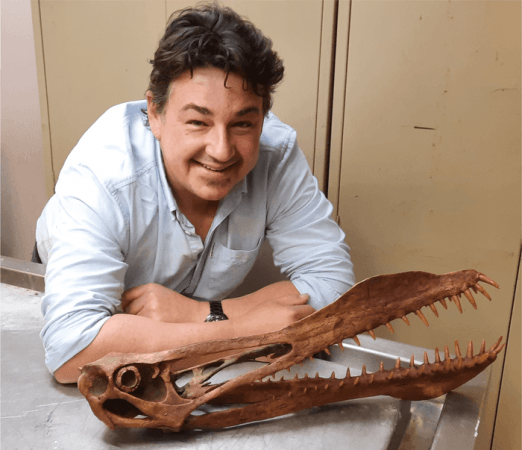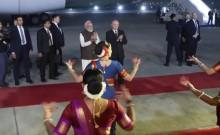Australia's largest flying reptile has been uncovered, a pterosaur with an estimated seven-metre wingspan that soared high in the skies like a dragon above the ancient, vast inland sea once covering much of outback Queensland.
The fossil was found in a quarry of Wanamara Country, in the northwest of Richmond in June 2011 by Len Shaw, a local fossicker who has been 'scratching around' in the area for decades. University of Queensland PhD researcher Tim Richards from the Dinosaur Lab in School of Biological Sciences, led a research team that analysed the fossil of the creature's jaw to find the startling features.

"It's the closest thing we have to a real life dragon," Mr Richards said. "The new pterosaur, which we named Thapunngaka shawi, would have been a fearsome beast, with a spear-like mouth and a wingspan around seven metres."
The new species was named after the local First Nations peoples of Richmond, incorporating words from the now-extinct language of the Wanamara Nation. The genus name, Thapunngaka, incorporates thapun [ta-boon] and ngaka [nga-ga], the Wanamara words for 'spear' and 'mouth', respectively," Dr Salisbury said.

"The species name, shawi, honours the fossil's discoverer Len Shaw, so the name means 'Shaw's spear mouth'." The fossil of Thapunngaka shawi is on display at Kronosaurus Korner in Richmond.
One metre-long Skull
Mr Richards said the skull alone would have been just over one metre long, containing around 40 teeth, to grasp many fishes at a time and was known to inhabit Queensland's no-longer-existent Eromanga Sea.
"It's tempting to think it may have swooped like a magpie during mating season, making your local magpie swoop look pretty trivial – no amount of zip ties would have saved you... To be clear, it was nothing like a bird, or even a bat – Pterosaurs were a successful and diverse group of reptiles – the very first back-boned animals to take a stab at powered flight," he explained.

The new species belonged to a group of pterosaurs known as anhanguerians, which inhabited every continent during the latter part of the Age of Dinosaurs. Being perfectly adapted to powered flight, pterosaurs had thin-walled and relatively hollow bones. Given these adaptations their fossilised remains are rare and often poorly preserved.
"It's quite amazing fossils of these animals exist at all," Mr Richards said. "By world standards, the Australian pterosaur record is poor, but the discovery of Thapunngaka contributes greatly to our understanding of Australian pterosaur diversity."
It is the third species of anhanguerian pterosaur known from Australia and all three species hailing from western Queensland.








![Sky is the limit: IndiGo is now tenth largest airline by capacity globally; growth indisputable [details]](https://data1.ibtimes.co.in/en/full/767455/sky-limit-indigo-now-tenth-largest-airline-by-capacity-globally-growth-indisputable-details.jpg?w=220&h=135)